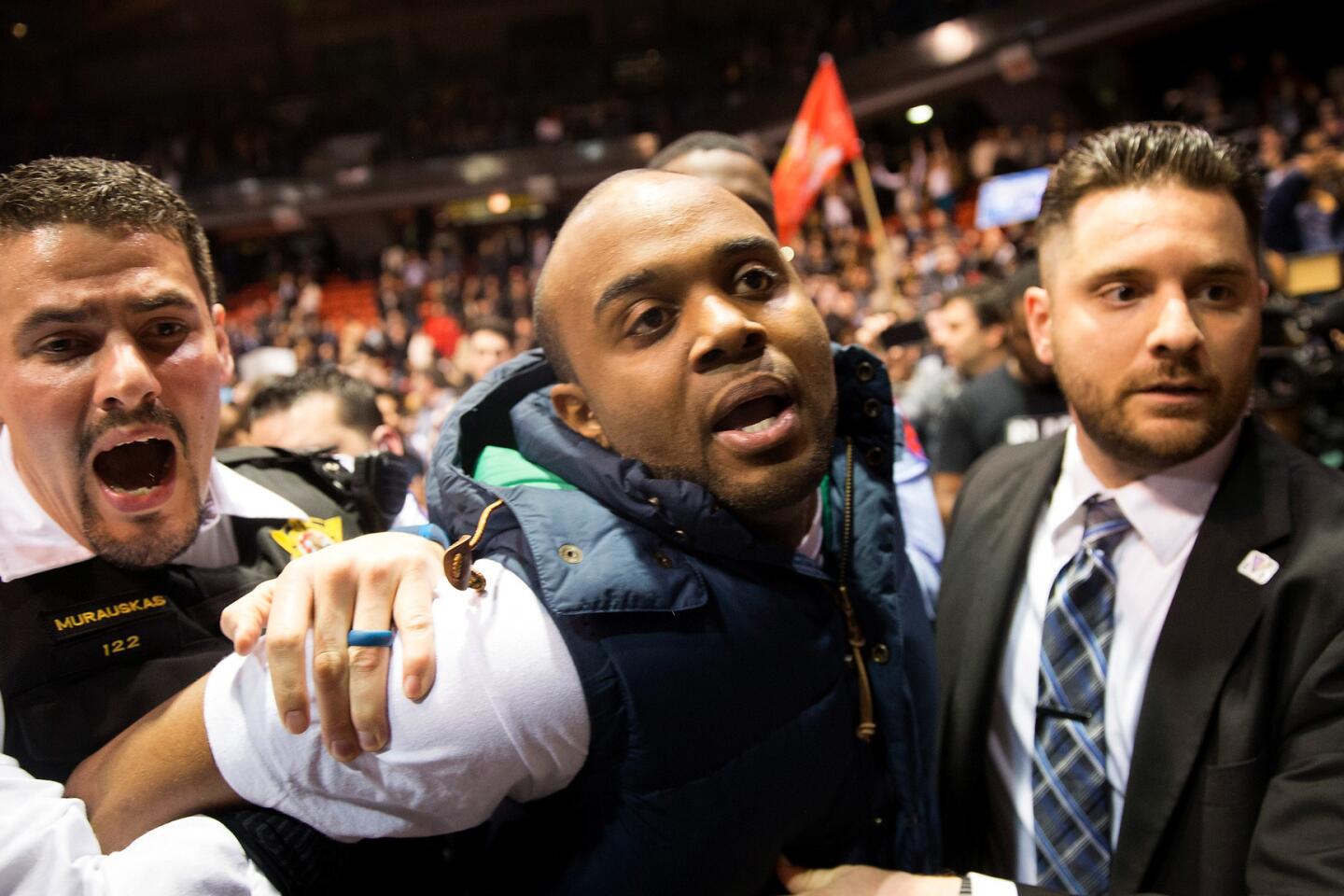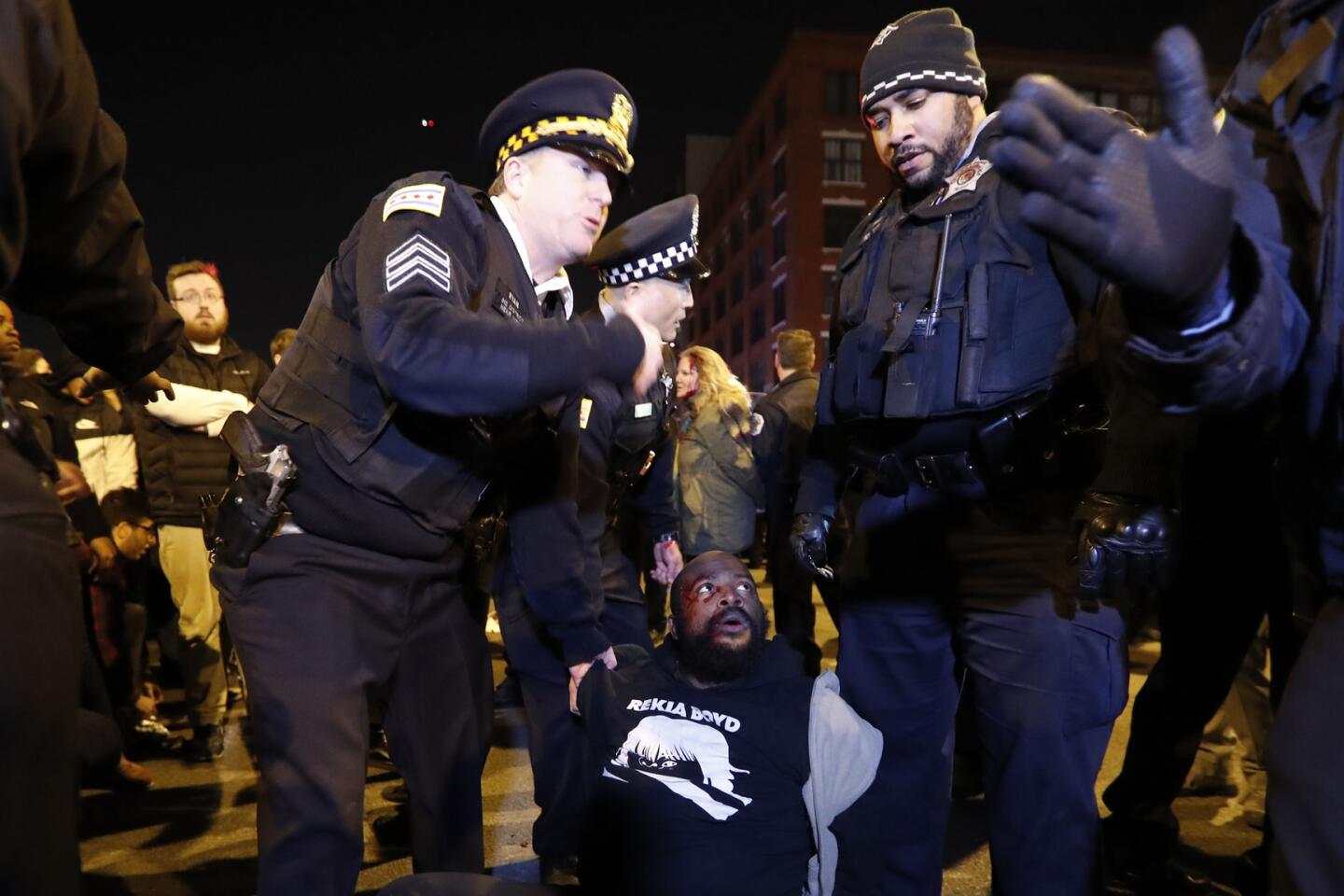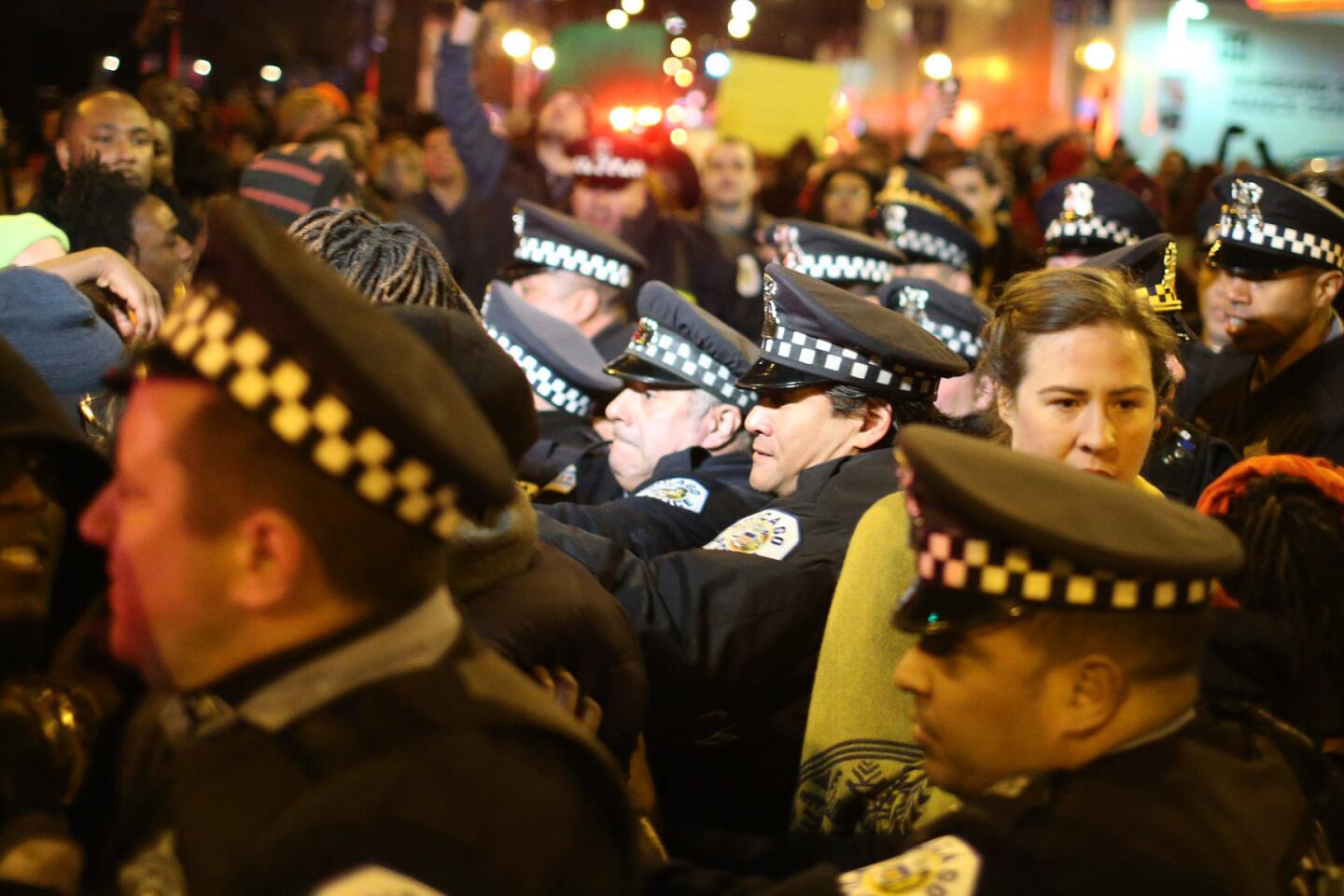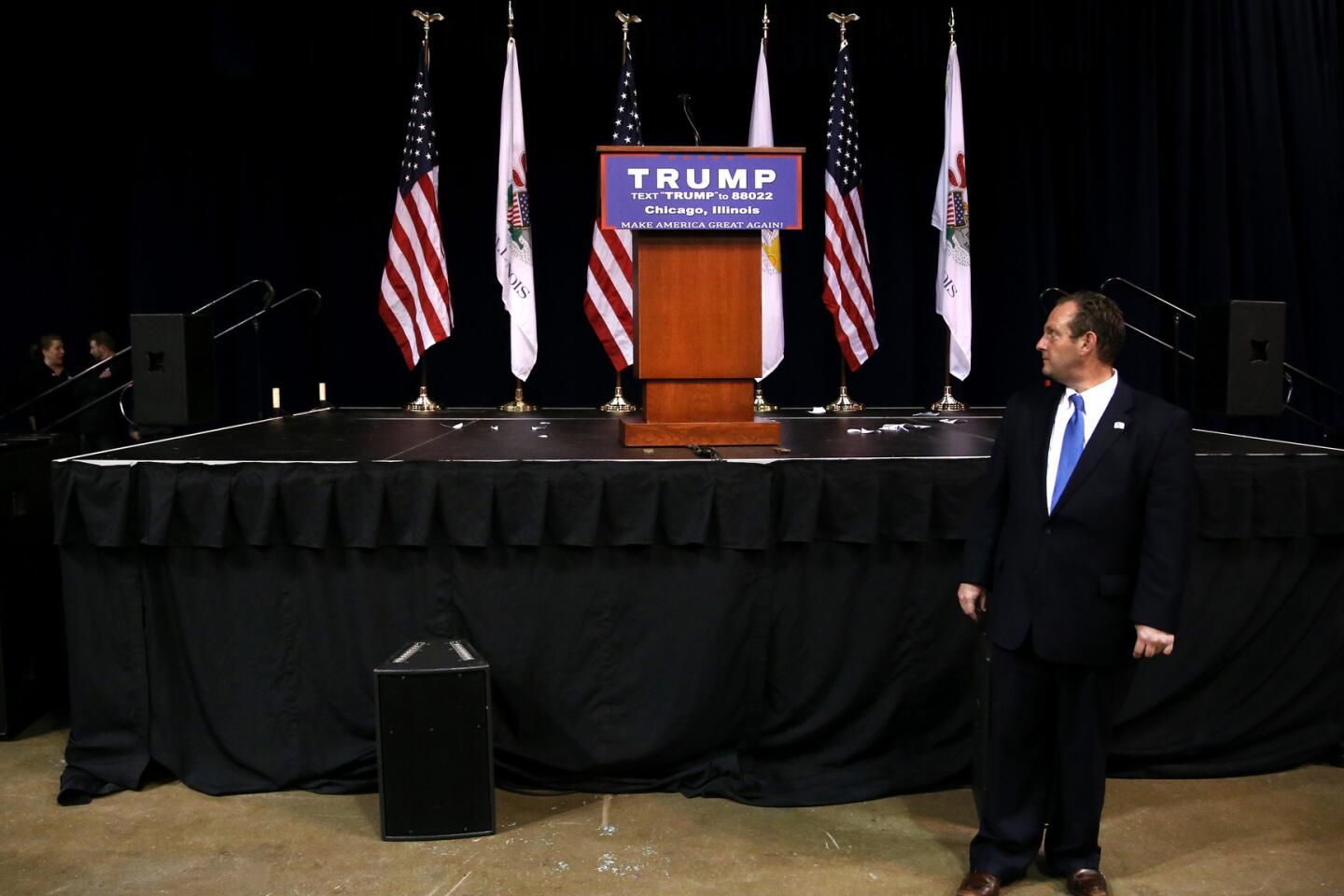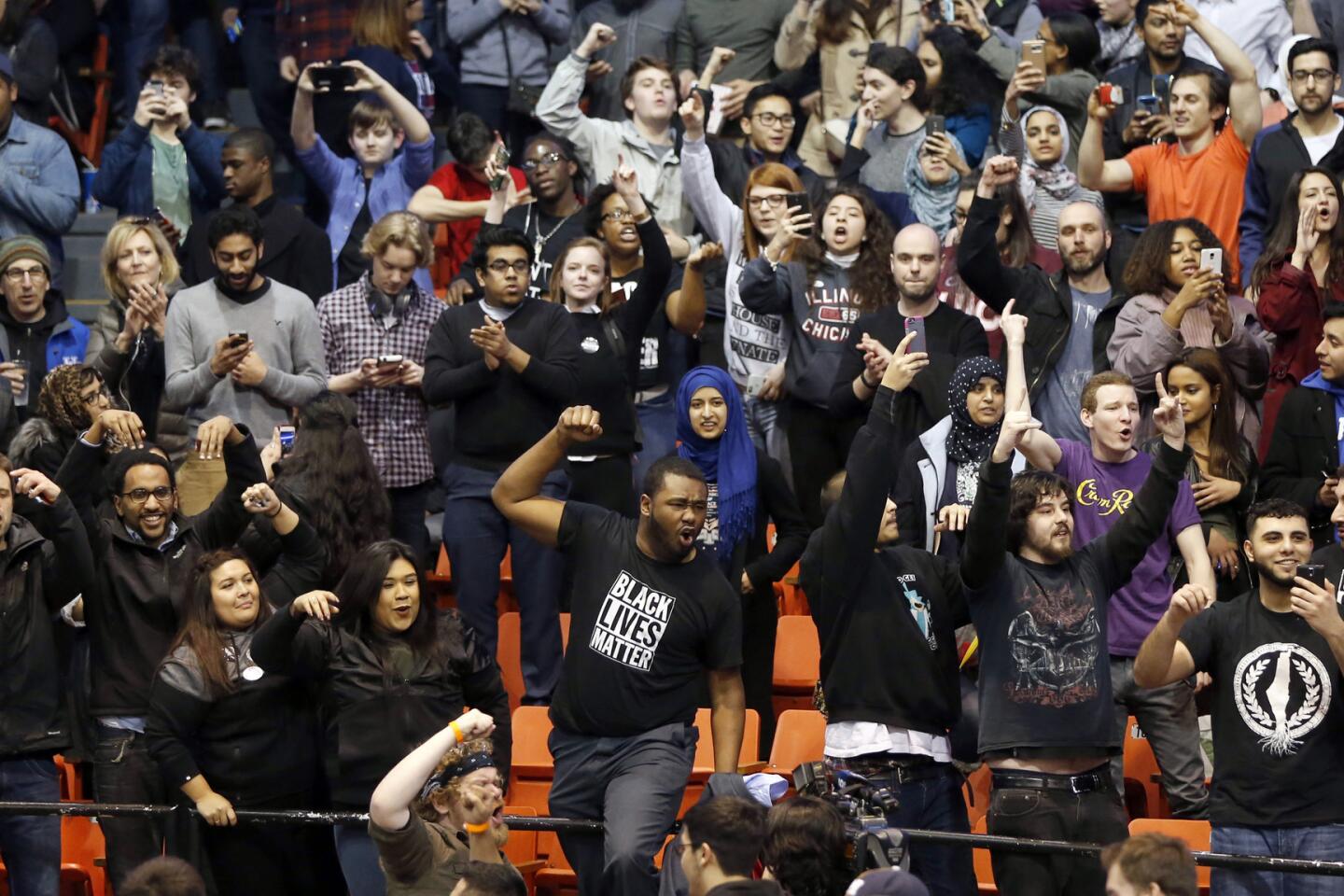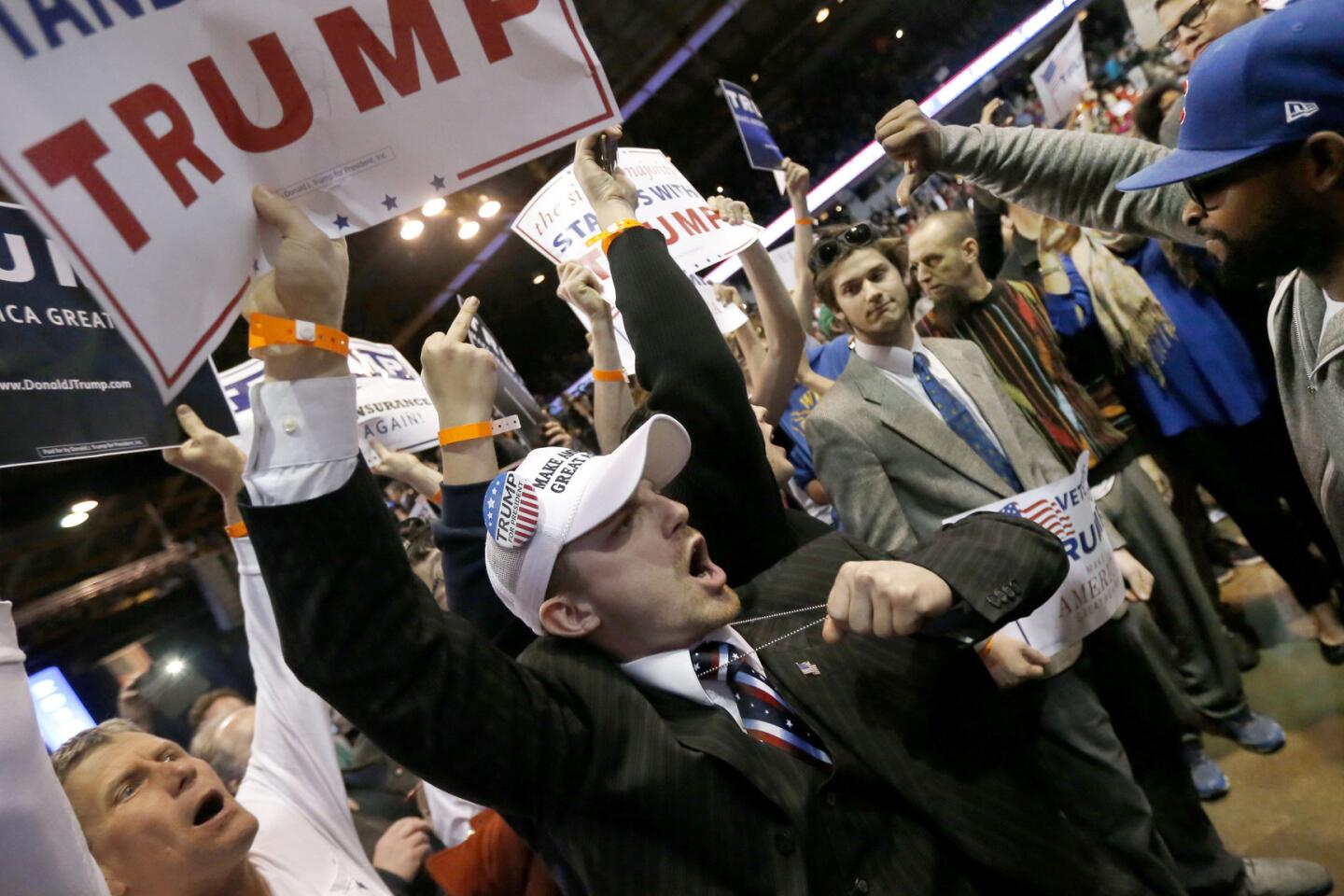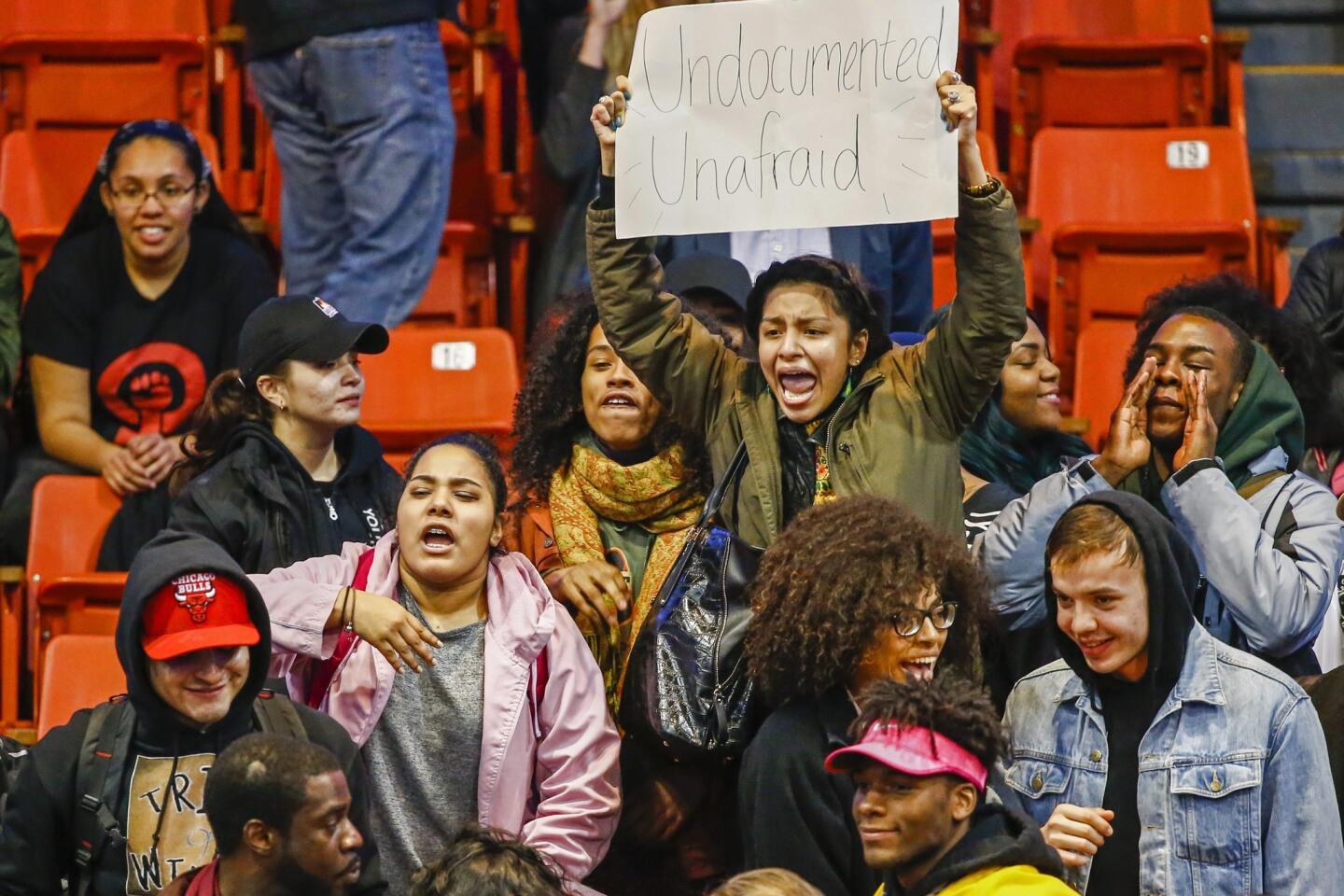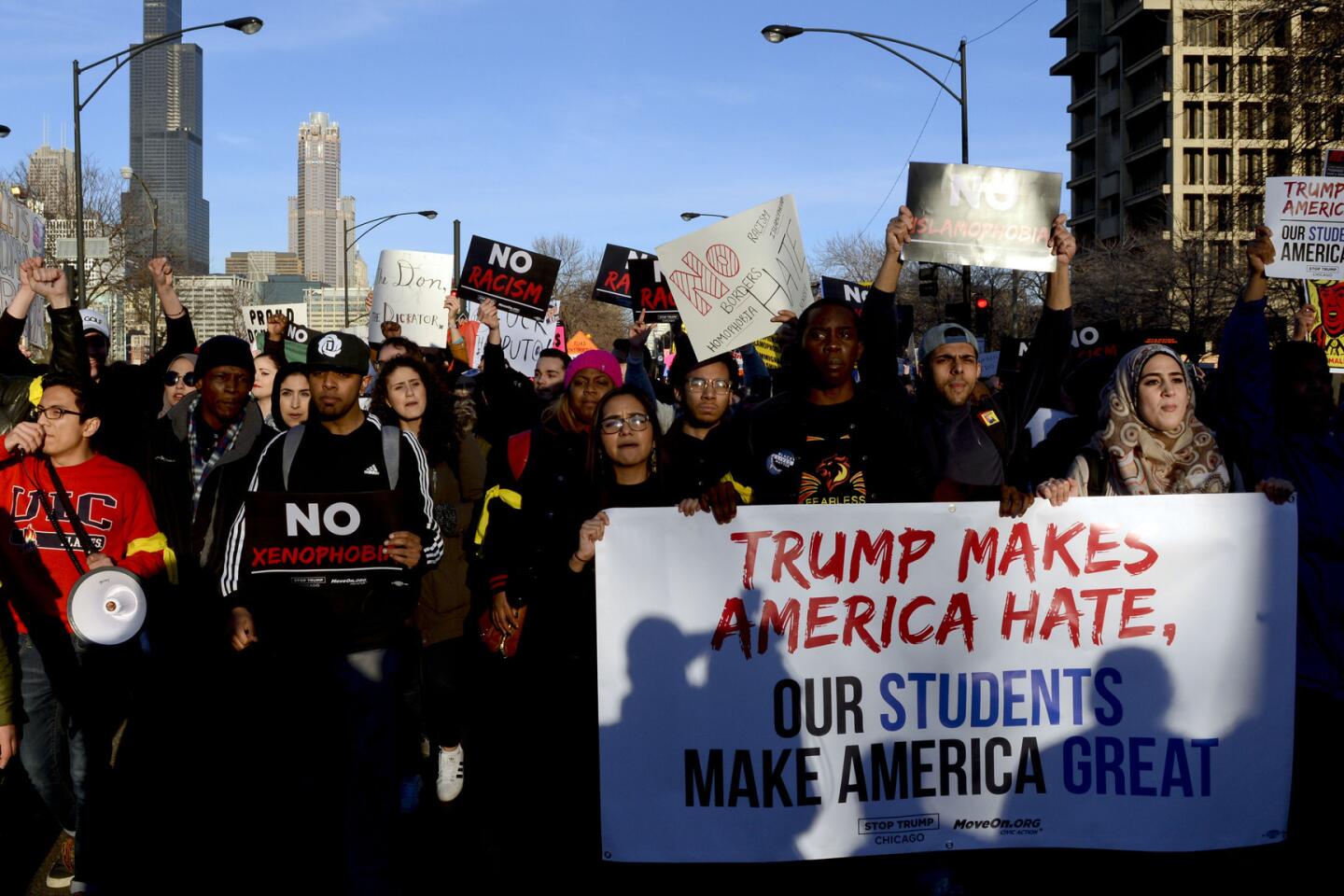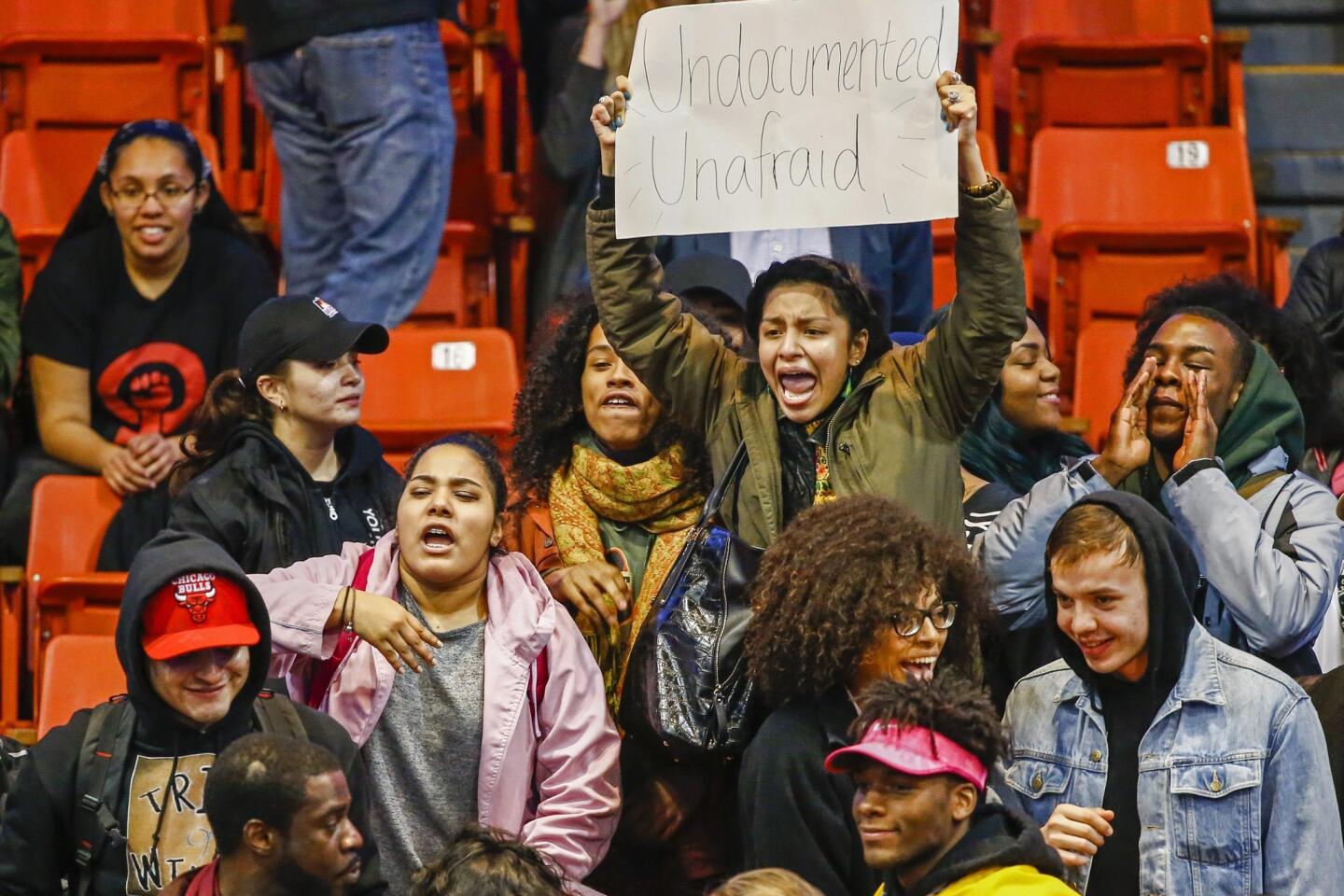Analysis: Campaign violence and Donald Trump: Hardly surprising, entirely predictable
- Share via
Violence splashed across the television screen Friday night like a horrific flashback from the 1960s, as fistfights and shoving broke out among thousands of supporters and opponents at a Donald Trump event in Chicago, drawing memories of police and protesters fighting in the streets of the same city during another political gathering in 1968.
Nothing about it was surprising.
Election 2016 | Live coverage on Trail Guide | March 8 election results | Track the delegate race | Sign up for the newsletter
What many had feared as Trump’s campaign has proceeded had finally happened on a large scale: A flammable brew of populist anger, campaign mismanagement, a candidate’s own provocative encouragement and protesters fighting back — quite literally — finally found its fuse. The explosion was predictable, given tensions in the country around its changing demographic face and economic displacement that has left many fearful and upset, receptive audiences for Trump’s surprisingly strong candidacy.
Trump himself was not present; he canceled his event a half-hour after it was due to begin, citing security concerns. The candidate’s statement said that the campaign had determined that “for the safety of all of the tens of thousands of people that have gathered in and around the arena,” the event would not be held. It was after the cancellation that clashes broke out among audience members and between audience members and police.
“Please go in peace,” the Trump statement said.
Peace will be a hard sell, because much of this plays to the desires of the participants.
Trump has yet to back down from any of the incendiary, race-based comments he has made during this campaign; only the night before he had insisted in a Republican debate that he was correct in asserting Muslims “hate” Americans. Moreover, his tough stance on matters such as building a wall on the Mexican border, and his history of drawing huge crowds, are central to his political argument that he alone is strong enough and popular enough to win the White House.
Although Republican establishment figures and his fellow candidates demanded Friday that he call a halt to the turmoil, it is very possible that within the Republican base, Friday’s events will cement support of him. Richard Nixon benefited from political and racial violence in 1968 at the Democratic National Convention in Chicago and elsewhere.
Trump’s crowds, while mostly peaceful, have included those instigating violence, and their actions have been applauded by other Trump supporters. Earlier this week, a 78-year-old Trump supporter sucker-punched a black protester being led out of the candidate’s event — and then threatened death to the man he had punched.
The anti-Trump cadres themselves played a role in the violence. Protesters who had been able to infiltrate his events in small bunches somehow on Friday were able to get into his Chicago event in vast numbers and force its cancellation — their largest anti-Trump victory to date and one that at least some of them will probably want to replicate.
Trump’s campaign staff and security teams are responsible for safety at the events, but they are — as Friday night showed — clearly not a match for the thousands who pour into his rallies.
All that considered, nothing seemed likely to change simply from the shock of seeing it all play out on television.
In a hastily arranged interview Friday night on CNN, Trump denied that he bore any blame for his caustic treatment in the past of protesters and his campaign focus on Mexicans, Muslims and people in China and Japan who he says are taking American jobs.
“I don’t take responsibility,” he said. “Nobody’s been hurt in our rallies.” At the same time, he brought up his denunciation of immigrants and reiterated the harm he said had been done to America by those here illegally.
He placed blame for Friday’s and other events on protesters who he said had been “unbelievably abusive.” “I think we’ve been very mild with protesters,” he said. “Until today we never really had much of a problem.”
In many ways, Trump is the continuation of a long line of political figures who have played on the emotions of the crowd, often by using racial cues or outright statements to enrage their followers and outrage their opponents. This form of demagoguery has been particularly dangerous in the days of the civil rights movement and beyond, and in times of economic difficulty.
In 1968, running a third-party candidacy for the presidency, the former Democratic governor of Alabama, George Wallace, campaigned with the veneer of race and violence ever present. He blamed “anarchists” for demonstrating at his events and encouraged cameras to focus on them, thus feeding his campaign’s argument that the nation was beset by anarchy. He insisted that right-thinking Americans should “do away” with the demonstrators.
Wallace did not overtly talk about race, but he didn’t have to: He had been a public segregationist as governor. He also repeatedly brought up issues such as fair housing laws — initiated to protect minorities — as topics of concern. By the time he finished riling up the crowds, Washington Post political writer David Broder once wrote, they resembled “a lynch mob.”
The Republican strategy for taking back the South after Democratic President Lyndon Johnson signed civil rights and voting rights legislation led to other veiled activities. Ronald Reagan, elected governor of California in 1966 after campaigning against the state’s fair housing act, kicked off his 1980 post-convention presidential campaign swing with an appearance near Philadelphia, Miss., where three young civil rights workers had been found dead 16 years earlier. Those slayings were attributed to members of the Ku Klux Klan and local law enforcement officers.
Reagan’s speech that day segued directly from a denunciation of welfare to wording used by segregationists: “I believe in states’ rights,” he said. His aides denied that his intent was racial.
Race also flavored the 1992 presidential campaign of a Reagan aide, Pat Buchanan, who mocked others in racial terms and said immigrants who refused to “assimilate” threatened the country.
But given the immediacy that today’s media environment allows, no one has been able to spread a race-inflected message further than Donald Trump. He entered the race best known politically for challenging — without proof — President Obama’s citizenship. He immediately began campaigning for a wall to separate the U.S. and Mexico, and asserted that immigrants coming here illegally were “rapists” and “murderers.” He called for a halt to allowing Muslims to enter the country.
And he inflamed audiences with biting references to those who opposed him.
Hours before he was to appear in Chicago, the New York real estate mogul taunted demonstrators whose shouting interrupted him in St. Louis.
“Go home and get a job,” Trump snapped at the Missouri protesters. “Go home to Mommy.”
He has often seemed to use the disruptions as a device to demonstrate his own power: “Out, out, out!” he demanded a week ago in Warren, Mich., each time protesters interrupted. After he did, his supporters chanted “U.S.A.! U.S.A.!”
Trump has openly pined for “the old days,” when, he says, noisy demonstrators would be carried out of a political rally on stretchers.
“I’d like to punch him in the face,” he told a Las Vegas casino rally crowd last month when one protester was ejected.
His suggestion came true Wednesday when a white Trump supporter named John McGraw punched a black protester in Fayetteville, N.C., and declared to “Inside Edition” that “next time we see him, we might have to kill him.” (McGraw was charged with assault and disorderly conduct.)
Protesters, sometimes affiliated with the Black Lives Matter movement, have become more and more numerous at Trump events in recent weeks. In St. Louis, they prevented Trump from speaking for long stretches of time.
“Missouri, I can’t believe this,” Trump said. “I can’t believe it.”
He also became impatient with the police.
“Where are the police?” he asked. “Come on, police, get ‘em out. Let’s go. Let’s go. Come on.”
Trump also criticized the protesters, saying they were “destroying our country.” But he conceded, as he often does, that there was an up side to getting heckled.
“Can I be honest with you? It adds to the flavor,” he told his cheering supporters. “It really does. It makes it more exciting. I mean, isn’t this better than listening to a long boring speech?”
The night before, at the presidential debate in Miami, Trump had been confronted with all of his inciting comments about protesters, and was asked again if he bore any responsibility.
“We have some protesters who are bad dudes, they have done bad things,” he said. “And if they’ve got to be taken out, to be honest, I mean, we have to run something.”
On Twitter: @cathleendecker @finneganLAT
ALSO
Podcast: The media’s Donald Trump obsession
Chaos breaks out at Trump rally in Chicago
Ben Carson backs Donald Trump, ‘a very intelligent man’
Donald Trump has a history of endorsing violence against protesters
More to Read
Get the L.A. Times Politics newsletter
Deeply reported insights into legislation, politics and policy from Sacramento, Washington and beyond. In your inbox twice per week.
You may occasionally receive promotional content from the Los Angeles Times.
